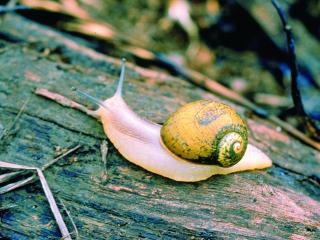Chemical control
Few chemicals are registered in Australia for controlling snails and slugs with methiocarb, metaldehyde and Iron EDTA used as baits.
Iron EDTA baits pose a reduced risk of poisoning to children and animals.
Since some slug species may be naturally tolerant to methiocarb, metaldehyde baits should be used for slug control, especially in crop situations.
Timing is the most critical aspect of control when using baits. Trying to control pest snails and slugs when they are a problem, usually in spring, is the least effective method because:
- The population is at its greatest at this time.
- Most of the population is juvenile and is not very mobile and so has a reduced chance of contacting the baits.
- There is ample alternative feed available, which competes with the baits, so less bait is eaten.
- There is usually an excess of plant growth, so the baits get lost and the chance of a snail or slug coming in contact with them is greatly reduced.
- Rainfall is still quite heavy, so the life of baits in the field is reduced.
Baits
The best time to bait is in autumn (late March to April), before the break of the season, or soon after the late autumn rains arrive because:
- Adult snails and slugs are killed before they get a chance to lay their eggs. Eggs are laid in soil which is damp enough to germinate grasses.
- Snails and slugs are hungry after spending the summer period inactive and there is little alternative feed to compete with the baits.
- The ground is comparatively bare so the chance of a snail contacting a bait is increased.
- Rain is infrequent, so the field life of baits is extended.
Effective control can also be achieved by opportunistically applying baits when snails or slugs are activated by thunderstorms in summer.
Do not mix copper products (copper sulphate, Bordeaux mixture) or other products with the baits to try to improve their performance — copper is highly repellent to snails and slugs and they will not eat a bait that has been contaminated with it.
If you are using sprays of any kind when you want to bait, apply the spray first, wait for it to dry, then apply the baits so they are not tainted by the spray.
The size of the bait is important, especially for broad scale applications. The smaller the bait pellet, the more baits there are per unit weight and the better the coverage. For instance, if the size of a bait is halved in all three dimensions, there will be eight times as many baits for the same weight.
Clear the ground surface before baiting by mowing or cultivating and spraying weeds along treelines and fencelines. This will improve the performance of the baits.
Applying baits in strips around the perimeter can prevent re-invasion of an area. This is required for vegetable crops and to prevent the spread of white Italian snails. Apply these treatments two to three metres wide to clean-cultivated borders or fire-breaks. Alternatively, apply them in a continuous line along the bottom of a furrow, but only attempt this on level ground, or soil erosion may result.
Warning
Avoid accidental poisoning of small children and dogs by careful application of baits.

